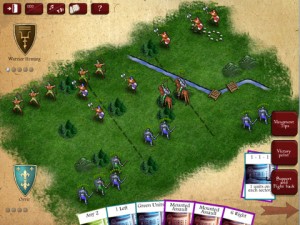
Greenstone Games sent me a copy of their game Seven, the Card Game to review. Actually, they sent me two copies.
Seven is simply described as Go Fish+. It uses the mechanics of Go Fish as a base, changes them slightly and adds special cards into the mix. When I described the game as such to the designer and publisher, he received it politely but I could tell that he was annoyed. I don’t really understand why. It’s not like this isn’t obvious from the very moment that you read the rules and throughout the entire play of the game.
The cards are somewhat flimsy, which I’ve come to expect as a general rule from new publishers (though many spring for more substantial card stock). The artwork is amateurish; however the designer indicates that they have another artist lined up for another edition.
The Game
The deck contains seven sets of seven different cards, and twenty-one special cards (which include some duplicates). On your turn, if you have one of the items in one of the sets, you may ask any other player for one of the other items in that set. If he or she has it, he or she gives it to you, and you get to go again. If not, you have to go fish pick a card and play passes to the left.
(See?)
Once per turn you may play a special card if you have one, which give you various benefits, such as looking through the deck for a card, or through someone else’s hand, or additional chances to guess wrong. “Joker” cards you play on another player’s turn and let you lie about a card when asked and end that player’s turn.
And that’s it. Game ends when the sets are all collected, and the player with the most sets wins.
Impressions
I’m not a fan of Go Fish. Taking that into account, the game is roughly on par with the experience you would get playing Go Fish.
In Go Fish, when you call a card from a set, you get all the cards from the other player that he or she has in the set; you don’t have to guess which one they have. This prevents that player from simply asking you right back for each and every card that you took from them on their turn, something that happened dozens of times during our game. The other people I played with actually found this very amusing, and so, if you’re into that kind of light-hearted back and forth silliness, you may find this enjoyable.
The special cards are decent, though if one player gets an unequal share of the better ones they’ll have an advantage, naturally. They were distributed equally enough in our game so that that wasn’t a factor. The designer indicates that they are tweaking the special cards for the next edition.
Contest
I can’t really end without mentioning their contest. They got a babe to lie down and cover herself in nothing but cards for a contest wherein you have to guess how many cards are in the picture. What can I say? I’m only human.
- Comments Off on Second Look — Seven, the Card Game
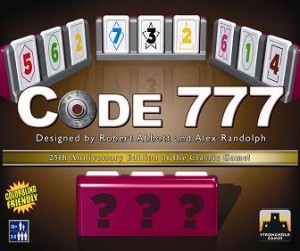 Is it possible to write a positive review of a game that you really don’t like? I don’t mean say nice things because the publisher gave you a copy (which in this case they did). I mean, is it possible to appreciate a game’s quality even though you’d rather not play it again?
Is it possible to write a positive review of a game that you really don’t like? I don’t mean say nice things because the publisher gave you a copy (which in this case they did). I mean, is it possible to appreciate a game’s quality even though you’d rather not play it again?
For Code 777 by Stronghold Game, I’m going to try.
You see, for me Code 777 wasn’t fun. And yet, I think it’s a good game.
Code 777 is a deduction game. Remember Mastermind? Yeah, like that, only multiplayer and tougher. The game includes 28 tiles, numbered one through seven and in seven different colors. But it’s not that each number matches a particular color. No, numbers one through four are each a single different color, but numbers five and six come in two colors each, and number seven in three colors. (By the way, colors are matched with symbols to make the game colorblind friendly.)
To start the game, each player draws three tiles and places them in a rack facing away (so they can’t see what they have on their own rack). Then in turn, each player draws a question card and answers it based on what she sees on the other players’ racks. For example, one question is, “On how many racks can you see 3 different colors?” Another is, “Do you see more yellow twos or more yellow sevens?” As they go around the table gathering more information from each other’s answers, the players should eventually be able to deduce what tiles are on their own racks (numbers and colors). A player that guesses correctly gets a point. A player who’s guess is incorrect must swap out for three new tiles, thus starting over with zero information. The first player to three points wins.
Though the game comes with special notepads to help players keep track of answers to the questions, sorting through the information is no easy task. Concentration is necessary. On top of that, there’s the pressure to guess before an opponent. Overall, Code 777 presents a very challenging puzzle. If you like that sort of thing, Code 777 delivers. These days, I’m generally looking for something a little less intense.
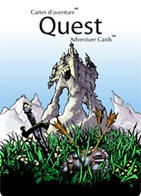 Canadian sggc Le Groupe Conseil K2 sent me a complimentary copy of their game, Quest Adventure Cards, for review.
Canadian sggc Le Groupe Conseil K2 sent me a complimentary copy of their game, Quest Adventure Cards, for review.
The game is a “ccg” sold in 6 different unmarked packs; that is, when you buy a pack of cards, you get one of the 6 packs, you just don’t know which one you’ll get. You can buy three random packs from their site (strangely, you must click on “News”, not “Sales” to do this) for $15 in Canada, or more elsewhere.
You need 3 packs of cards per player. The maximum suggested number of players is 4. Each player starts with 3 cards in hand.
Cards
There are 3 types of cards:
- Quest: These are kept in a separate deck at the top of the playing field. 2 quests are face up at any time.
A quest card lists 2 or 3 required items; once you have these items in play, you have “completed” the quest. The quest card also lists optional additional items that you can have in play and that will be added to your completed quest, if you complete the quest.
When you “complete” a quest, take the quest card and place it on top of all the cards in your playing area that you used to complete the quest (required and optional). These cards are now locked-in points (cannot be affected by actions). Another quest card is flipped up to replace the one taken.
- The remaining cards form the draw deck:
- Action: Play the card, do what the card says. You may play only 1 action on your turn.
- Item: An item card required to complete a quest. Play it into your play area on your turn. These cards are analogous to the cards required to complete the goal in Fluxx. Items cards have values from 2 to 8, which are their point values when they are in play on within your completed quests. There are duplicate items and alternate versions of certain items.
Play
Draw 2 cards, play up to 3 cards, discard down to 5 cards.
You may play only 1 action card on your turn. When you play a card, you may:
- Put it into play, but only if it is listed as a required or optional item on one of the face up quests, and only if you don’t already have one of those items already in play.
- Put it into your treasury. You may have any number of items in your treasury.
- Take it from your treasury and put it into play, following the above rules.
You may ask yourself: why would I ever discard a card if I can always put cards into my treasury? Good question. I don’t know.
But here’s the weird thing about discarding: when you discard (spent actions are out of the game, not discarded) you discard to the middle of the deck. This rule is repeated more than once in the rules, so it must be important, but for the life of me, I still don’t get the point. Why? And what, exactly, is the middle of the deck, anyway?
Some action cards let you steal or swap cards from other players’ hands, play areas, or treasuries. The rules on some of these cards are unclear, which is to be expected from a self-published game by an sggc. Not a big deal, but something to clear up with an FAQ.
Game End
The game ends when a number of quests equal to 2 x the number of players have been scored. At that point, add up all your points in play, including all point in your collected quests. High total wins.
However, and this is a big however, if the draw deck runs out before the required number of quests is completed, the game ends in a tie. So, if you’re losing, and the draw deck is running out, your job is to prevent anyone (including yourself) from finishing the last quest.
Rules
The review copy I received was six packs of cards, one of each set. No rules were included, but these are available online. The online rules are long and a somewhat stilted translation from the Canadian French, but they are sufficient to understand the play. An online demo is also available, also very long but clear and thorough.
Components
After looking at the cards, I asked the publisher if I had received final quality cards or some demo copy; they assured me that I had received an actual published copy. Too bad. The card quality is flimsy, which is bad enough. What is worse is that they weren’t cut properly at the printers, and some of the cards had jagged serrations on the bottom edges; unplayable other than for demo purposes, really.
The artwork is nice enough.
Review
This is not a gamers’ game. I played twice, and didn’t experience a moment of interest at any time. I suppose there may be some decision making, but the decisions were brutally obvious. If you have items that match a quest, you play them. If not, you dump them in your treasury. If you have an action card that might do some good, do that first. That’s it. The game played me, nearly entirely. You simply waited to draw the items you needed.
The publisher suggested that the game was enjoyed mostly by kids aged 8 to 13; I expect that kids in that age group will enjoy the game, but I can’t see a kid actually loving the game. Not enough happens; it’s mostly looking back and forth between the little text printed on the quest card and the various names and categories printed on the item cards in your hand and treasury to see if you have a match.
And I really disliked the game ending in a tie if you don’t complete the quests, which happens, I expect, all too often.
- Comments Off on Second Look: Quest Adventure Cards
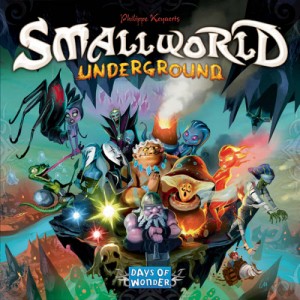
Recently I was able to get a few games of Small World Underground in, thanks to Days of Wonder sending me a review copy. I’ve had a blast playing the original on my iPad, and was ecstatic about getting the chance to try this new version.
Underground is a stand-alone game, but is fully compatible with the original. All the pieces between the two games can be swapped back and forth, and used in combination. There’s a section in the Underground rulebook that explains how to work this.
For those not familiar with Small World, it’s an area control game where players take control of various races vying to take and hold territories on the board. Once your race’s numbers thin out, you can decline that race and choose a new one, scoring bonus points each turn for the previous race markers you have on the board. The original was pretty straight forward in this aspect, and every race had its own unique powers combined with a random special power attached to it. This helped serve to mix things up a bit, and give players a chance to one-up each other and try various tactics to achieve more ground.
Underground takes this premise and expands upon it greatly. There are now fortifications that make it harder to take over certain territories. There are also monsters placed on the board at the start of the game that aren’t controlled by any player. By overcoming these monsters you can uncover treasures or monuments that give you even more special abilities to use in your conquest. While that may not seem like it add much to the game, it really does. There were times when a single artifact was able to turn the tide of a game and get me back on the path to victory.
The game is professional from top to bottom. Something I’ve come to expect from a Days of Wonder game. Even the game insert is functional for both storing, and playing the game. DoW even provides instructions for how to setup the insert and repack the box. No space is wasted.
I do have one complaint about the game. The rulebook is horrible. It’s well and good to get you going, but it also leaves a lot of questions about certain races’ powers, when they can be used, and how exactly they’re used. It seems vague in a lot of places, and feels like they trimmed power explanations in order to keep the rulebook shorter. Is it enough to keep you from buying and playing the game? No. Is it annoying? A bit.
Overall I’d say that Small World Underground is worth a purchase. If you have the original, this is a great way to expand your game. If you don’t have the original, skip getting it and move straight to Underworld. It’s by no means necessary to have both, and you’ll get more game out of Underworld.
Days of Wonder provided a copy of Small World Underground as a review copy to Purple Pawn.
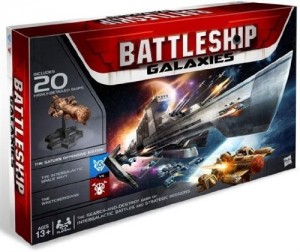 Right up front I should tell you that I was primed to like Battleship Galaxies and it did not disappoint me! I’ve been waiting nearly 2 years for it—ever since Mike Gray announced at Gen Con that Hasbro was working on a game targeted at the mass market but designed with strategic game-play that would be appreciated by hobbyists. I’m also a sucker for spaceships, and Battleship Galaxies is a spaceship combat game with 20 very nice plastic miniatures.
Right up front I should tell you that I was primed to like Battleship Galaxies and it did not disappoint me! I’ve been waiting nearly 2 years for it—ever since Mike Gray announced at Gen Con that Hasbro was working on a game targeted at the mass market but designed with strategic game-play that would be appreciated by hobbyists. I’m also a sucker for spaceships, and Battleship Galaxies is a spaceship combat game with 20 very nice plastic miniatures.
Besides the plastic miniatures in two factions—the Intergalactic Space Navy, or ISN, (the good guys) and the Wretcheridians, or Wretch, (the evil alien invaders)—the game includes player screens, coordinate dice, tactic cards, blue and red pegs, energy boards, ship cards, obstacle and discovery tiles, and battlefield game boards. The ship cards detail the capabilities of the ships, with three versions for each one, standard, seasoned, and veteran. Obstacle and discovery tiles provide terrain interest to an otherwise plain space battlefield. Energy boards are used to track available energy, which is needed to launch and activate ships, charge weapons, and play tactic cards. The blue and red pegs record remaining shields and hull damage. Tactic cards provide players with heroes, ship upgrades, additional weapons, events, and sabotage tricks.
The basic rules for Battleship Galaxies are pretty simple. Players start the game with 15 energy points, 5 tactic cards, and a fleet of ships off the board. At the start of each turn, a player receives 10 more energy and 1 additional tactic card. Then by spending energy, the player can launch ships onto the board, as well as activate ship cards to move and fight with the corresponding miniatures. The exact setup and winning conditions are set by the scenario, though in most cases the game ends when one player simply eliminates all of the other players’ ships from the board.
Movement and combat are also straightforward. Each ship has a set number of spaces that it can move. Weapons have a range and when they hit inflict damage to shields and hull. Facing doesn’t matter, neither is line-of-sight an issue. On the other hand, different weapons have different energy charge costs, range, damage strength, and sometimes limitations on the type of ships that they can target. The larger ships also have the ability to carry the smaller ones, which can be a more efficient use of energy, but risks multiple ships lost from a single hit.
Battleship Galaxies accommodates 2-4 players and, in my experience, takes about 2 hours to play a game, depending on the scenario and player experience. One of the more interesting elements of the game is the tactic cards, though these can be left out for a simpler game. On the Wretch side, with skillful use of the tactic cards you can actually board and take over an opponent’s ship. Another is the discovery tiles (alien artifacts, warp gate, etc.), which when landed on can increase the range of weapons, provide energy, or allow a ship to jump to the other side of the board.
In terms of similarities to Battleship, there aren’t many. The game’s lead designer, Craig Van Ness, told me that the team was inspired by Battleship but was trying to build a game that would be more engaging to a new generation. As with the original game, hits are recorded with small plastic pegs. Also, though the guessing element isn’t there, when firing a weapon, the attacking player rolls the ten-sided letter die and the eight-sided number die and calls out the combined result (as in, “B-3”). The defending player looks that up on the targeted ship’s card hit location chart (a matrix overlayed with an profile of the ship) to see whether it’s a hit or miss. If the hit location has a red star and the ship has no shields, critical damage destroys the ship immediately (“You sunk my battleship!”).
So what do I think about it? Battleship Galaxies is easy easy to learn, yet involves some interesting tactical decision-making. The story behind the game is explained in a very nice graphic novel about the Wretcheridian invasion. And it’s got spaceship combat with cool miniatures. I love it! All the parts work together well and I’ve found that choices in the game can switch the momentum in the game from one side to the other at any point, making it very engaging. Buy it.
Hasbro provided a complimentary copy of this game for review.
- Comments Off on Second Look — Battleship Galaxies
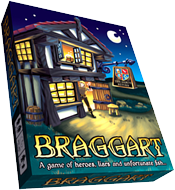 I finally got a chance to get Braggart to the table the other night, playing it 2 player with my wife.
I finally got a chance to get Braggart to the table the other night, playing it 2 player with my wife.
The first thing I’ve got to say about the game is that it’s incredible simple to play. Every turn cards are flipped up from the deck equaling the number of players. Starting with the person who has the “My Round” card, players pick which card they’d like to put into their hands. After that players take turns either drawing 3 cards, of playing a boast. Playing a boast is as simple as laying down a Deed card and a Foe card, optionally playing a Scene and Result card. After all the players make their boasts, card numbers are totaled and the player with the highest boast puts their cards into a pile to be scored at the end. All the other players may choose one of the cards they played to keep, and discard the others.
It’s pretty straight forward.
There’s a little wrench thrown in of Liar and Outrageous Liar cards, and Ploy cards. Ploys can be played before you boast, and allow to you steal cards, draw more cards, etc… Both types of Liar cards are played during another player’s boast, and allow you to replace 1 or 2 of their played cards with cards from your hand. You then get to keep the cards you switched out.
The cards in the game are humorous, and even with just 2 players we were coming up with some pretty crazy combinations. I believe one of my lowest scoring Boasts was “I wet myself in front of…” “…an angry chicken.”
It took us around an hour to play, but the deck is pretty big for just two players. We got a good chuckle out of the game. It’s pretty mindless, but I’m sure it’d be much better with a full compliment of 6 players.
Is the game deep? No. Is there a lot of strategy? No. This is strictly a filler game, meant for a lot of players who like a good laugh. If that’s what you’re looking for, it’s definitely worth the money.
You can find Braggart on the Spiral Galaxy Games website for £8.33.
Spiral Galaxy Games provided a free copy of Braggart to Purple Pawn for review.
- Comments Off on Second Look—Braggart
 I received a prototype review copy of 1955: The War of Espionage, which was designed by Kevin Nunn, from Nicholas Vitek at Living World Games. 1995 underwent a successful funding campaign on KickStarter. Living World Games is also an advertiser on Purple Pawn.
I received a prototype review copy of 1955: The War of Espionage, which was designed by Kevin Nunn, from Nicholas Vitek at Living World Games. 1995 underwent a successful funding campaign on KickStarter. Living World Games is also an advertiser on Purple Pawn.
1955 is a two-player tactics card game. The board consists of six tracks representing countries. The allegiance marker on each country’s track indicates its allegiance; the goal is to a) move the allegiance marker of the opposing player’s home country to your side of the board, or b) move any three allegiance markers to your side of the board.
Most people playing this game will have already played Z-Man Games’ 1960: The Making of a President, and it’s a nearly perfect description to simply call this game “1960-lite”. Supposing that you haven’t played 1960, the game plays as follows: Each round you play two cards from your hand; at the end of your turn, you draw back up to five cards and may move your spy meeple to any country.
Each card can be played either for its direct influence value, which moves a marker in a country 2-4 steps toward your side of the board, or its special ability. The special abilities can have varying actions, such as moving several different markers 1 step each, moving your or your opponent’s spy, increasing your hand limit, and so on.
Playing a card for its direct influence value is not as simple as it sounds. A card can be played for influence in the country named on the card, or in the country in which your spy is located, or in your home country; however, different rules apply in each of these cases. In some situations, you add or subtract 1 to the influence of the card, and in some situations you may add an additional card to boost the influence value. In addition, when your opponent plays cards for influence, you are allowed to drop as many cards of a certain type as you like to counter his play, but only in your home country or in the country in which your spy is located; again, certain rules apply to boost or subtract from the value.
Exactly when you do each of these things is a little confusing, and I hope they are cleared up by the time the production version of the game rolls off the assembly line.
When you first play, you tend to want to play cards for their direct influence; it looks wasteful to play them in an other way. As you play more, you realize the potential of playing the special abilities. That’s a good thing, because without the special abilities, the game would devolve into a nearly endless game of tug of war. Even with the special abilities, it can occasionally feel like tug of war for a few turns, but someone usually top-decks a card to break the loop. One alleviating effect that the rules provide is to “lock” a marker once it reaches the end of a track, although one card type can unlock it again.
I can’t tell you about the components, since my copy is a prototype. The graphics will be spiffed up, but remain generally the same; I find them to be serviceable. The spy meeple is cute.
70% of the games sent to me to review are pretty bad; 1955 is an exception. It’s a nice two-player strategy game. I wouldn’t call it great, but I enjoy it and would play it again. It takes about 30 minutes to play.
- Comments Off on Second Look: 1955: The War of Espionage
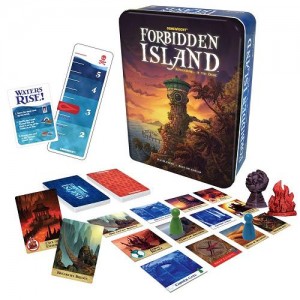 My wife refers to Forbidden Island as stress-in-a-box, and while I tend to agree with her, I still recommend it as a great family game. Forbidden Island manages to incorporate a fair degree of tension without being grim. The game is based on an Indiana Jones-like theme, where the players are an archaeological team, working together to rescue four treasures from a sinking island. The art and location names in the game do a great job of inspiring a sense of adventure, as do the amazing figures for each of the treasures!
My wife refers to Forbidden Island as stress-in-a-box, and while I tend to agree with her, I still recommend it as a great family game. Forbidden Island manages to incorporate a fair degree of tension without being grim. The game is based on an Indiana Jones-like theme, where the players are an archaeological team, working together to rescue four treasures from a sinking island. The art and location names in the game do a great job of inspiring a sense of adventure, as do the amazing figures for each of the treasures!
Playing Forbidden Island isn’t difficult, but winning it is another story entirely. Every turn, sections of the island flood, with the water rushing in faster as the game progresses. Players have to balance fighting the flood with collecting the sets of matching treasure cards necessary to claim the Earth Stone, Statue of the Wind, Crystal of Fire, and Ocean’s Chalice, and then escape with them off the island. If sections flood making it impossible to retrieve even just one treasure, the game is lost. If a single player is caught in a flooded section and unable to swim to safety, the game is lost. If the helicopter landing space is flooded so that it’s impossible for the players to make their escape, the game is lost. Or if the water is rushing in so fast that it overwhelms the meter, the game is lost.
Yet as challenging as it is to beat, the game’s cooperative nature—remember, the players work together as a team—makes it worthwhile and an especially good family game. Every member of the team has an opportunity to contribute, and cooperation is key to making it off the island with all four treasures.
The difficulty of Forbidden Island can be adjusted to the players’ level of experience. Also sandbag cards help with shoring up the island, and each player has a special skill based on their role on the team (for example, the diver can swim through flooded terrain). So all is not lost. Yet more often than not, it’s a nail-biter, with the team barely making it out ahead of the flood. And that’s what makes it fun!
Forbidden Island sells for around $15, which is an amazing deal for a game that comes in a metal tin and includes such high-quality pieces. It’s published by Gamewright, who gave me a copy to review.
UPDATE: A fellow Pawn, Richard Bliss, just got off the phone with Richard Borg. Apparently Richard hadn’t even heard of Puffin Software or Viking Lords, and was quite shocked to see his game so blatantly ripped off. Richard is going to look into how to pursue legal action. Purple Pawn in no way condones the actions of Puffin Software.
Have you ever played any of the Commands & Colors games, specifically BattleLore? If so, you’ll feel right at home playing Viking Lords on your iPad.
The game play is identical to Richard Borg’s Command and Colors system. You have a left flank, center, and right flank that your units play on. You’ve got 3 classes of units: fast but weak, well balanced, and strong but slow. The only things that Battlelore has that Viking Lords doesn’t is Lore and Lore Masters.
Is the game any good? Yes, it is. You’ve got 15 maps, 18 unique units on each side, and the ability to play against the AI. You can play a campaign, a quick skirmish, or play online. The graphics aren’t the best in the world, but they’re not the worst either. All this for $3.99, and you’ve got yourself a good time for a good price. I really hope the game gets future updates with more maps, units, and maybe something similar to a Lore system.
Puffin Software provided a free copy of Viking Lords for review. Viking Lords can be found on the iTunes App store for $3.99 for the iPad.
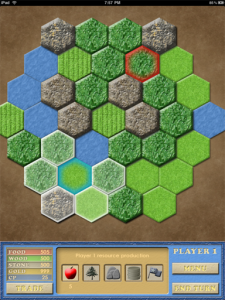 Back in October I had posted about New World Colony, a board game released for the iPad.
Back in October I had posted about New World Colony, a board game released for the iPad.
Since then I’ve had the opportunity to play the game, and even got early access to version 3 (which is now in the App Store)
The game really does feel like a cross between The Settlers of Catan and Risk. Every turn you get resources from the tiles you own, which let you build forts, walls, seaports, mills, etc… You also use resources and gold to invade adjacent tiles that don’t belong to you.
There’s several game modes with various winning conditions, several map sizes, and now there’s even the ability to play single player against the computer. Mutliplayer is seamless and simple using Apple’s Game Center, and there’s even 17 achievements to earn.
The base game is free, and I highly recommend you pick it up if you have an iPad. If you really enjoy it, there’s some unlock-able extras for a small fee.
Erik Asmussen provided a free copy of the unlocked game for review purposes.
Trending
- Massdrop.com
- Oh the Irony—Illuminati Card Game Continues to Inspire Conspiracy Theorists
- Footprints, an Educational Ecology Game
- USPS Adds Board Game Flat Rate Box
- Home
- Baila, the Estonian Drinking Card Game
- Crystal Caste Wins Dice Patent Suit Against Hasbro
- Hasbro and Mattel Merger?
- Are Board Games Dangerous?
- Board Games Based on Hindu Mythology
Archives
Most Popular Articles
- Oh the Irony—Illuminati Card Game Continues to Inspire Conspiracy Theorists
- The 20 Most Valuable Vintage Board Games
- The Truth About Dominoes On Sunday in Alabama
- Sequence Game, and Variants
- USPS Adds Board Game Flat Rate Box
- Baila, the Estonian Drinking Card Game
- The 13 Most Popular Dice Games
- Are Board Games Dangerous?
- Guess Who? The Naked Version
- What Happened to the Jewel Royale Chess Set?
Recent Posts
- Toy Fair 2019—Breaking Games
- Talisman Kingdom Hearts Edition
- Toy Fair 2019—Winning Moves
- Toy Fair 2019—Games Workshop
- Toy Fair 2019—Star Wars Lightsaber Academy
- Toy Fair 2019—Stranger Things Games
- Toy Fair 2019—HABA
- Licensing Roundup
- Game Bandit
- 2018 A Difficult Year For Hasbro But Not For D&D Or MtG
Recent Comments
- on Toy Fair 2019—Winning Moves
- on Game Bandit
- on Second Look—Dungeons & Dragons Waterdeep Dragon Heist
- on Crowdfunding Highlights
- on Beyblade SlingShock
- on Game Bandit
- on Game Bandit
- on Watch This Game!, the Board Game Review Board Game
- on Second Look—Vampire: The Masquerade 5th Edition
- on Palladium Books Loses Robotech IP License, Cancels Five-Year-Overdue Robotech RPG Tactics Kickstarter

